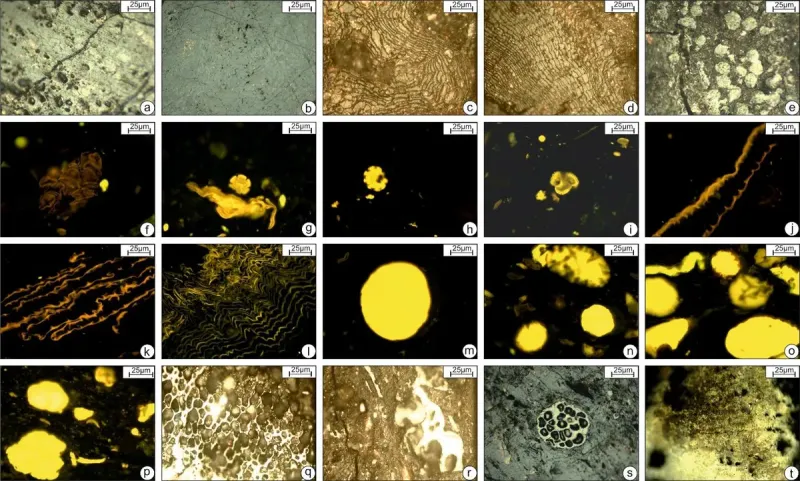
Image: Representative photomicrographs of the various macerals and mineral matter recorded in the studied lignite samples. Source: Supplemental Information.
As our planet grapples with the escalating impacts of climate change, tropical rainforests, Earth's most biodiverse ecosystems, face unprecedented threats. Understanding how these vital habitats responded to past climatic shifts is crucial for predicting their future. A new groundbreaking study published in iScience offers a remarkable journey back in time, revealing the secrets of a vibrant Eocene rainforest in western India, preserved in fossilized amber. This ancient ecosystem, teeming with life 40 million years ago, provides a powerful analog for the challenges and resilience of biodiversity in a warming world.
Researchers reconstructed a middle Eocene tropical ecosystem from amber biota found in the Harudi Formation, specifically at the Umarsar Lignite Mine in western India. Dating back approximately 41.6 to 40.8 million years ago, this period was characterized by a "hothouse" climate, with mean annual temperatures around 25°C and rainfall averaging 2,450 mm per year—conditions strikingly similar to modern tropical climates. What they discovered was an incredibly diverse ecosystem, home to over 800 arthropods of various taxonomic ranks, alongside 78 genera and 118 species of palynomorphs (fossil pollen and spores). This rich tapestry of life reinforces the ESAT (energy-stability-area-time) theory, which posits that high solar energy input, long-term climatic stability, expansive geographical area, and sufficient evolutionary time are key drivers of immense biodiversity.
This research was carried out by a team of researchers from the Birbal Sahni Institute of Palaeosciences, Lucknow; American Museum of Natural History, New York, USA; Department of Earth Sciences, Indian Institute of Technology Bombay; and Southern Regional Centre, Zoological Survey of India, Chennai.
Did You Know? The Eocene Epoch (56 to 33.9 million years ago) was one of the warmest periods in Earth's history, often called the "Eocene Paradise" due to the widespread proliferation of tropical flora and fauna. |
To unravel the mysteries of this ancient rainforest, the scientists employed a suite of sophisticated techniques. The primary source of information was the fossilized amber itself, which acts as a natural time capsule, preserving minute details of biological inclusions like insects and plant fragments. Palynology, the study of fossil pollen and spores, allowed them to reconstruct the ancient flora. Entomology focused on identifying and classifying the arthropods trapped within the amber. Beyond the visible fossils, organic geochemistry, using techniques like Gas Chromatography-Mass Spectrometry (GC-MS), analyzed biomarkers such as terpenoids and n-alkanes to understand the types of plants present and the environmental conditions. Organic petrography examined macerals (organic components) in the lignite samples, providing further clues about vegetation and depositional environments.
To estimate the paleoclimate, the team used the Coexistence Approach (CA) and the Nearest Living Relative (NLR) method. This involved comparing the climatic preferences of the fossil taxa's closest living relatives to infer ancient temperatures (mean annual, cold month, warm month) and precipitation (mean annual, wet month, dry month, warm month). This interdisciplinary approach painted a detailed picture of a frost-free, warm, and humid climate with minimal seasonal temperature variability, supported by high monsoonal rainfall.
The Eocene rainforest was not a uniform expanse but a heterogeneous landscape comprising three distinct floristic communities. Along the coast, mangrove forests thrived, characterized by plants like Rhizophora and Avicennia, evidenced by specific organic markers and geological features indicating marine influence. Further inland, a dense, multi-storied lowland tropical rainforest dominated, featuring woody angiosperms such as Dipterocarpaceae, Fabaceae, and Arecaceae. This forest had an emergent layer of towering trees, an upper canopy, and a sub-canopy/understory layer, each with its unique plant species. Freshwater indicators like the green alga Botryococcus and the ostracod Candona pointed to the presence of ponds and swamps within this forest. In transitional, or ecotonal, zones, subtropical, temperate, and deciduous elements intermixed with tropical flora, suggesting slightly drier forest margins or higher terrain.
Crucially, the study illuminated the complex web of trophic interactions that sustained this ancient ecosystem. Decomposers, including fungi, termites, and mites, played a vital role in nutrient cycling, breaking down deadwood and leaf litter. Herbivores, such as gall midges, beetles, ants, and Hemiptera, fed on plant tissues. Predators like spiders, predatory millipedes, and dolichopodid flies kept populations in check, while parasitoids, including wasps, added another layer of ecological complexity. Pollinators were diverse, with Melikertes bees likely pollinating canopy trees and non-biting midges and beetles servicing understory vegetation. Even hematophagous biting midges and mosquitoes were present, likely feeding on the blood of vertebrates like crocodiles, rodents, and early mammals.
This research significantly advances our understanding of early tropical forests, providing direct evidence from a low-latitude region where such detailed records are rare. While previous studies inferred aspects of ancient rainforests, this work offers an unprecedented look at the intricate trophic networks. However, the study acknowledges limitations, such as the assumptions of the NLR and CA methods (that ancient species had the same climatic preferences as their modern relatives) and potential preservation biases in amber, which might under-represent certain groups of organisms. Despite these, the findings offer robust insights into deep-time biodiversity patterns.
The societal benefits of this research are profound. By understanding how ancient tropical ecosystems, with their complex interactions, responded to past climate shifts, we gain invaluable analogs for predicting the resilience of modern rainforests to ongoing climate change. The study underscores that conserving biodiversity is not just about protecting individual species, but also about safeguarding the intricate ecological interactions and functional networks that underpin ecosystem health and stability. In a world facing rapid environmental change, these lessons from the Eocene are vital for guiding future conservation strategies and ensuring the survival of our planet's most precious ecosystems.
This article was written with the help of generative AI and edited by an editor at Research Matters.






